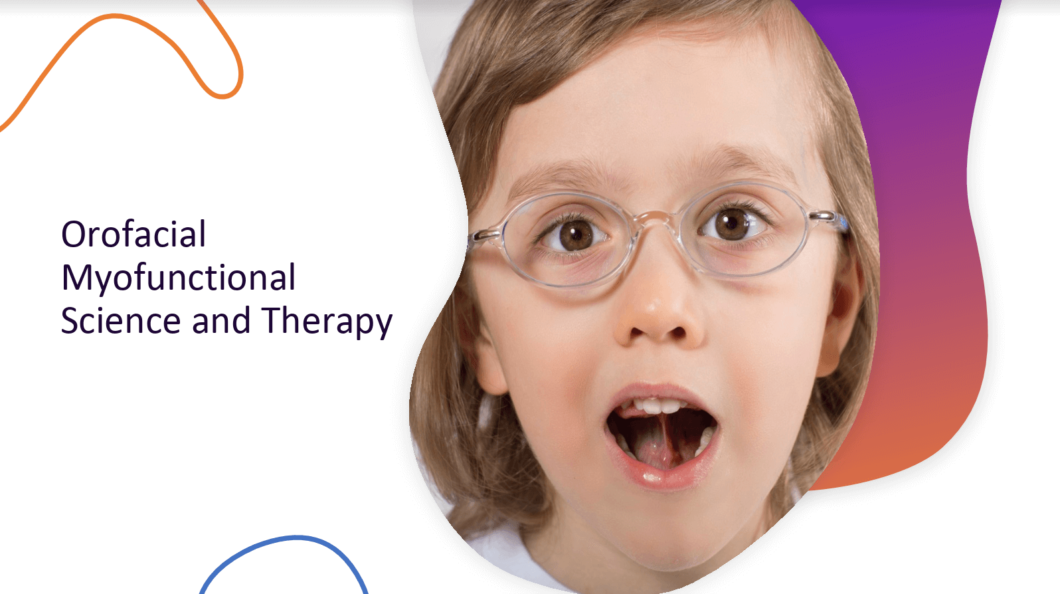Orofacial Myofunctional Science is the study of normal and abnormal functional patterns of the stomatognathic system; an anatomic system comprising teeth, jaws , associated soft tissues and their related functions. : breathing eating drinking and speech.
‘“More recently, advances sleep medicine recognise the role of airway for good quality sleep at night, & hails a new era and new role for myofunctional science and practice in medicine.”
– Sharon Moore
The study of Orofacial Myofunctional Science originated in the early 1900s, from Orthodontists who recognised that the rest position of the tongue could be an obstacle in orthodontic treatment. Currently, there is much interest in this field and a growing body of research to illuminate the role of oral rest postures in the early growth of the face, skull and jaws, its influence on dental growth, and its potential to interfere with orthodontic treatment goals. Untreated orofacial dysfunctions can mean some anomalies with speech production are resistant to treatment. We see this frequently with patients referred for speech problems that do not resolve with traditional speech pathology approaches. Sometimes these people have been in therapy for years getting nowhere!
The principles of evaluation and treatment of Orofacial Myofunctional Disorders are based upon dental science tenets: however, Orofacial Myofunctional therapy is not dental treatment per se and well-managed myofunctional diagnosis and intervention also draw upon behavioural and neuromuscular science, the psychology of habit change and a good understanding of the functional science around swallowing, chewing and speech. Professionals who train in this speciality area are Speech Pathologists, Dental Hygienists, Physiotherapists, Occupational Therapists as long as it is on their Scope of Practice, and this varies by state and country. However, many professionals show an interest in this area and use adjunctively in their patient management, including Dentists, Orthodontists, Osteopaths, Physiotherapists, Occupational Therapists and Chiropractors.
Speech Pathology and Orofacial Myofunctional therapy are like hands to a glove for Speech Pathologists working with Dentists and Orthodontists. Whilst additional training in Orofacial Myofunctional science is essential to manage the patient population effectively, Speech Pathologists are well versed in the neurophysiology of swallowing, chewing, speech, behaviour, learning and clinical goal setting throughout the lifespan. A Speech Pathologist’s background and expertise in clinical science, management of behaviour change, and their established expertise with swallowing, upper airway and speech disorders, make them ideal practitioners to study orofacial myofunctional science. Not only is it a useful skill with dental and orthodontic patients, there is growing indication that the effect of correct orofacial function from very early ages (baby-toddler-preschooler) has a fundamental influence on the growth of the upper jaw which in turn impacts not only speech and eating but also a mode of respiration. The small upper jaw, mouth breathing and orofacial myofunctional disorders often coexist. Is it the chicken or the egg that came first? Whichever came first, there are long-term implications for jaw growth. This is key. Most Speech Pathologists are not taught these skills in the undergraduate programs and will need to ‘up skill’ to adequately manage these types of referrals.
There is a good case to be made that Speech Pathologists, particularly those involved in Paediatric feeding have a profound influence on a baby’s face and skull growth from the early stages of feeding. Given that a child’s face and skull is 60% grown by the time they are 4 years old, therapy should be optimised to occur during natural phases of growth.
Paediatric caseloads are common to many Speech Pathologists through hospitals and health-based services. They are uniquely positioned to provide preventive, interceptive and rehabilitative interventions. Bearing in mind that early management of problems will mitigate later problems, it is best to create the conditions for ideal growth conditions at the earliest possible age. At a minimum, a Speech Pathologist can keep the issue of face, skull and jaw growth on their professional and clinical radar and make appropriate referrals and assist with parent education. If they are trained in orofacial myofunctional science they can make a more direct contribution via assessment, diagnosis and therapy alongside traditional clinical processes.
Not only that, for many patients both adult and paediatric there is a strong overflow between myofunctional disorders and a number of functional disorders of the upper airway e.g. where there are breathing issues at night that impact sleep quality like chronic snoring that progressively destroys the sensory receptors of the upper airway, it is not unusual for these adult patients to have chronic cough and symptoms of irritation that affect voice and can cause chronic cough. For children whose breathing is compromised at night, it is not unusual to have communication development delays and speech issues.
Fundamental education for parents at this formative stage could be pivotal in the child’s development, particularly when we consider the long-term major health implications of the suboptimal jaw and facial growth. This illuminates the need for early intervention and establishment of good habits in the early years of a child’s development. Actually form day one would be ideal! Optimising fetal health in utero? That would be even better! At the end of the day, parents affect the changes that are recommended by professionals and they will benefit enormously by understanding why they have been recommended to follow a particular type of intervention.
At Well Spoken we developed the approach and advocate pro-active optimisation by identifying and correcting problems while they are still ‘small’ and a ‘corrective’ approach as early as possible. However, we acknowledge that corrective interventions are never too late.
Due to the complex nature of Orofacial Myofunctional Disorders, a team approach (Dentist, Orthodontist, Pediatrician, Allergist, Osteopath where indicated…) and thorough analysis of the cause of the problem and all contributing elements of the problem is key to successful treatment. The complexity and potential interactions of aetiological factors related to orofacial myofunctional disorders (e.g., nasal obstruction, flow limitation in breathing, thumb sucking, anterior open bite, tongue tie and much more) need to be determined and managed in conjunction with treatment. Differential diagnosis is key e.g. does the orofacial myofunctional disorder reflect maladaptive neuromuscular patterns or is it contingent upon existing anatomical structures? This is exactly why a team approach and thorough analysis needs to be made.



